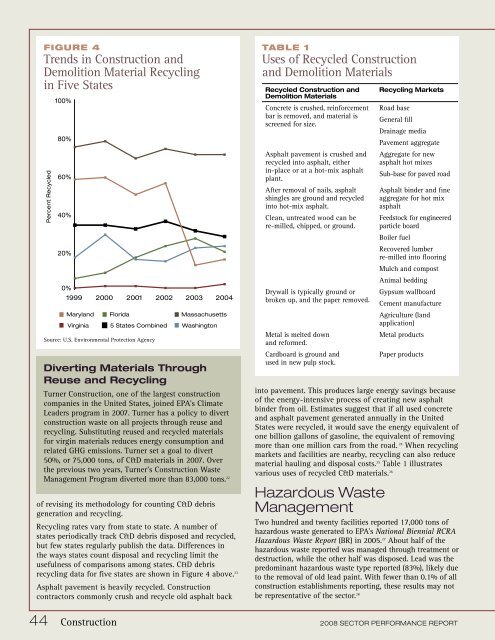2008 Sector Performance Report - US Environmental Protection ...
2008 Sector Performance Report - US Environmental Protection ...
2008 Sector Performance Report - US Environmental Protection ...
You also want an ePaper? Increase the reach of your titles
YUMPU automatically turns print PDFs into web optimized ePapers that Google loves.
Figure 4<br />
Trends in Construction and<br />
Demolition Material Recycling<br />
in Five States<br />
Percent Recycled<br />
100%<br />
80%<br />
60%<br />
40%<br />
20%<br />
0%<br />
1999 2000 2001 2002 2003 2004<br />
Maryland<br />
Virginia<br />
Florida<br />
5 States Combined<br />
Source: U.S. <strong>Environmental</strong> <strong>Protection</strong> Agency<br />
Massachusetts<br />
Washington<br />
Diverting Materials Through<br />
Reuse and Recycling<br />
Turner Construction, one of the largest construction<br />
companies in the United States, joined EPA’s Climate<br />
Leaders program in 2007. Turner has a policy to divert<br />
construction waste on all projects through reuse and<br />
recycling. Substituting reused and recycled materials<br />
for virgin materials reduces energy consumption and<br />
related GHG emissions. Turner set a goal to divert<br />
50%, or 75,000 tons, of C&D materials in 2007. Over<br />
the previous two years, Turner’s Construction Waste<br />
Management Program diverted more than 83,000 tons. 22<br />
of revising its methodology for counting C&D debris<br />
generation and recycling.<br />
Recycling rates vary from state to state. A number of<br />
states periodically track C&D debris disposed and recycled,<br />
but few states regularly publish the data. Differences in<br />
the ways states count disposal and recycling limit the<br />
usefulness of comparisons among states. C&D debris<br />
recycling data for five states are shown in Figure 4 above. 23<br />
Asphalt pavement is heavily recycled. Construction<br />
contractors commonly crush and recycle old asphalt back<br />
Table 1<br />
Uses of Recycled Construction<br />
and Demolition Materials<br />
Recycled Construction and<br />
Demolition Materials<br />
Concrete is crushed, reinforcement<br />
bar is removed, and material is<br />
screened for size.<br />
Asphalt pavement is crushed and<br />
recycled into asphalt, either<br />
in-place or at a hot-mix asphalt<br />
plant.<br />
After removal of nails, asphalt<br />
shingles are ground and recycled<br />
into hot-mix asphalt.<br />
Clean, untreated wood can be<br />
re-milled, chipped, or ground.<br />
Drywall is typically ground or<br />
broken up, and the paper removed.<br />
Metal is melted down<br />
and reformed.<br />
Cardboard is ground and<br />
used in new pulp stock.<br />
Recycling Markets<br />
Road base<br />
General fill<br />
Drainage media<br />
Pavement aggregate<br />
Aggregate for new<br />
asphalt hot mixes<br />
Sub-base for paved road<br />
Asphalt binder and fine<br />
aggregate for hot mix<br />
asphalt<br />
Feedstock for engineered<br />
particle board<br />
Boiler fuel<br />
Recovered lumber<br />
re-milled into flooring<br />
Mulch and compost<br />
Animal bedding<br />
Gypsum wallboard<br />
Cement manufacture<br />
Agriculture (land<br />
application)<br />
Metal products<br />
Paper products<br />
into pavement. This produces large energy savings because<br />
of the energy-intensive process of creating new asphalt<br />
binder from oil. Estimates suggest that if all used concrete<br />
and asphalt pavement generated annually in the United<br />
States were recycled, it would save the energy equivalent of<br />
one billion gallons of gasoline, the equivalent of removing<br />
more than one million cars from the road. 24 When recycling<br />
markets and facilities are nearby, recycling can also reduce<br />
material hauling and disposal costs. 25 Table 1 illustrates<br />
various uses of recycled C&D materials. 26<br />
Hazardous Waste<br />
Management<br />
Two hundred and twenty facilities reported 17,000 tons of<br />
hazardous waste generated to EPA’s National Biennial RCRA<br />
Hazardous Waste <strong>Report</strong> (BR) in 2005. 27 About half of the<br />
hazardous waste reported was managed through treatment or<br />
destruction, while the other half was disposed. Lead was the<br />
predominant hazardous waste type reported (83%), likely due<br />
to the removal of old lead paint. With fewer than 0.1% of all<br />
construction establishments reporting, these results may not<br />
be representative of the sector. 28<br />
44 Construction <strong>2008</strong> SECTOR PERFORMANCE REPORT















